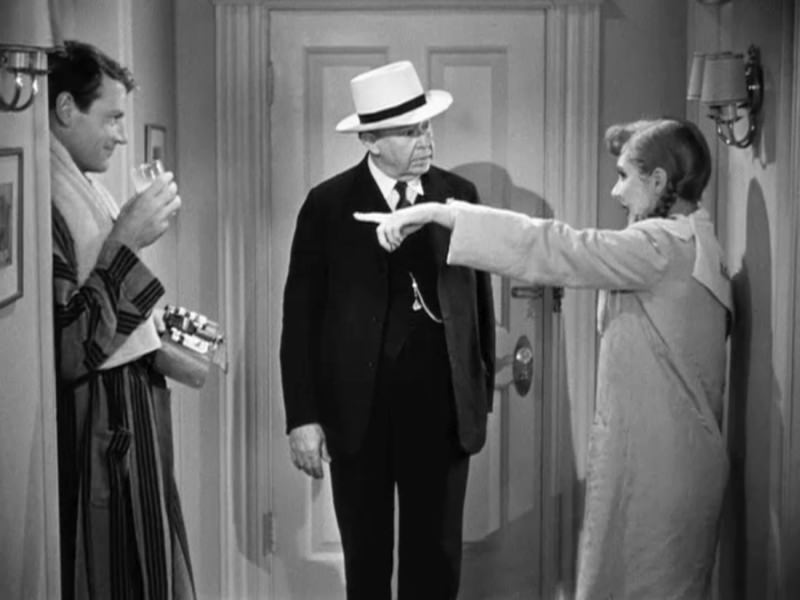The More the Merrier
Directed by George Stevens (1943) ***1/2
 The More the Merrier is considered by many film historians to be the last true screwball comedy (a genre which began in 1934 with It Happened One Night). Whether the last or not, it’s a breezy, funny film and a joy to watch.
The More the Merrier is considered by many film historians to be the last true screwball comedy (a genre which began in 1934 with It Happened One Night). Whether the last or not, it’s a breezy, funny film and a joy to watch.
The More the Merrier uses the housing shortage in Washington, D.C., during WWII as its backdrop. Charles Coburn plays a delightful millionaire codger, Benjamin Dingle, arriving in D.C. as an adviser on the housing shortage. When he finds his hotel room won’t be available for two days, he relies on his favorite inspiration, Rear Admiral Farragut’s admonition to “Damn the torpedoes, full speed ahead” and bulldozes his way into an apartment, convincing Connie Milligan (Jean Arthur) into subletting hers. The arrangement stretches credibility, but the screenplay sells it.
When it’s revealed Connie has a years-long engagement to an older, fuddy-duddy government bureaucrat, Dingle decides to play matchmaker and lures literally the first serviceman he sees on the street, Sergeant Joe Carter (Joel McCrea) into his apartment and sublets his portion. He also neglects to tell Connie that Joe is living there …
 The More the Merrier is sustained by three actors who are all masters of comic timing. McCrea’s nonchalant demeanor is especially striking; like a pre-Marlon Brando, he saunters through scenes as if he doesn’t necessarily care to be in a movie or not, which makes his casual, straight-faced responses all the funnier. The tight quarters allow the producers to create sexy situations, especially with the use of a paper-thin wall between bedrooms. Stevens, who began in the business as a cameraman working on Laurel and Hardy shorts, stages some frenetic physical comedy. The film is based on a short story by Garson Kanin (Born Yesterday, Adam’s Rib).
The More the Merrier is sustained by three actors who are all masters of comic timing. McCrea’s nonchalant demeanor is especially striking; like a pre-Marlon Brando, he saunters through scenes as if he doesn’t necessarily care to be in a movie or not, which makes his casual, straight-faced responses all the funnier. The tight quarters allow the producers to create sexy situations, especially with the use of a paper-thin wall between bedrooms. Stevens, who began in the business as a cameraman working on Laurel and Hardy shorts, stages some frenetic physical comedy. The film is based on a short story by Garson Kanin (Born Yesterday, Adam’s Rib).
One of the few faults is that the comedic tone gets lost in the third act, a common trait with screwball comedies, even classics like The Miracle of Morgan’s Creek (1942). (More recent films which attempt the same screwball comedy dynamics suffer the same fault; Jonathan Demme’s 1986 Something Wild is a good example).
 Richard Gaines as Connie’s fiancé is another weak link; this is unfortunately true of nearly every film I’ve seen him in, including classics like Double Indemnity (1944) and Ace in the Hole (1951). I don’t find his acting convincing.
Richard Gaines as Connie’s fiancé is another weak link; this is unfortunately true of nearly every film I’ve seen him in, including classics like Double Indemnity (1944) and Ace in the Hole (1951). I don’t find his acting convincing.
None of the original or reissue promotional posters were able to capture the spirit of the movie. One shows Arthur sitting sultrily, in a bathing suit, on a bed while McCrea and Coburn are hanging on a coat rack. Another shows Arthur taking one of her high heels off while seven women sleep in her bed! A reissue poster proclaims “The ONLY picture with a DINGLE” (?).
1943 may seem long ago, but The More the Merrier was at the tail end of several of its creators’ trajectories. It was the last comedy Stevens directed, after a long succession of popular films starting with the classic Alice Adams (1935). Jean Arthur was in only four more films before she quit Hollywood altogether. The More the Merrier was remade as Cary Grant’s last film, Walk, Don’t Run (1966).
The More the Merrier is available on Columbia Pictures DVD; no Blu-ray release yet.
—Michael R. Neno, 2017 May 10
